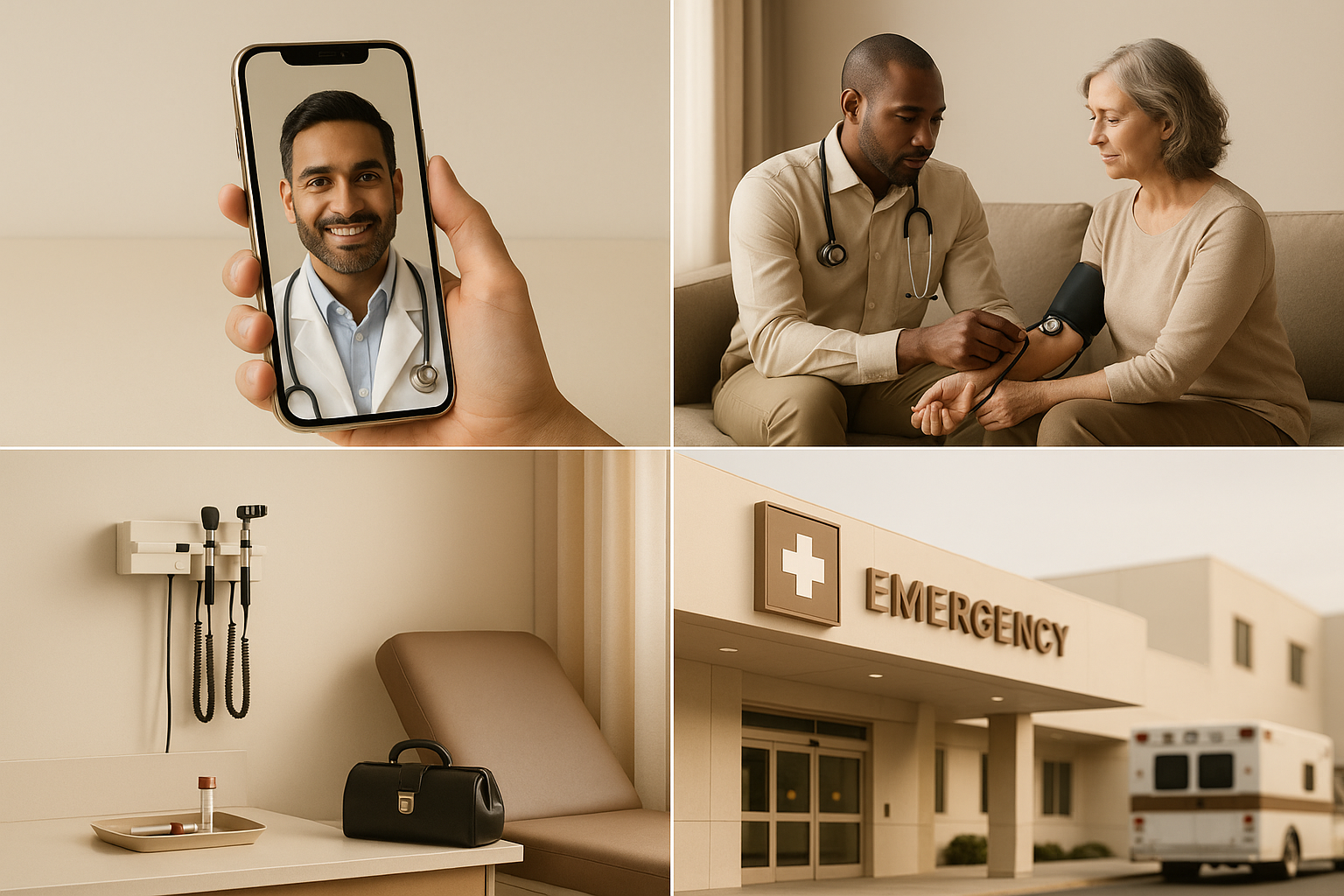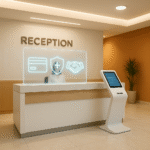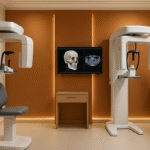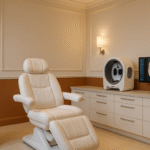Home Visit GP, Telehealth, Urgent Care or the Emergency Department: A Clear Decision Guide For Everyday Health Problems

When a health problem appears, the first decision is rarely about treatment. It is about where to go. Choosing poorly can waste precious time or leave you travelling when you should be resting. Choosing well moves you to the right level of care at the right moment, with the right team and the right tools. This guide explains, in plain language, how to decide between a telehealth appointment, a home visit GP, an urgent care clinic and the hospital emergency department. It frames the choice around safety, convenience, cost awareness and clinical capability, then applies that framework to common symptoms so you can act calmly and confidently.
SwissMed Clinic offers both in-clinic and at-home GP care. That detail appears only where it helps you move through the system efficiently. The aim is not to push you toward one door. It is to help you recognise which door makes the most sense for the situation you are in.
What each option actually provides
Telehealth is a remote consultation by video or telephone. It is best for issues that are primarily history-based or visual, such as renewing stable prescriptions, reviewing test results, assessing mild infections, discussing mental health concerns or following up a plan that is already in motion. Telehealth removes travel time and can start early triage when you are unsure where to go. Its limitation is the lack of hands-on examination, point-of-care tests and urgent procedures.
A home visit GP brings a clinician to you. This suits patients who are unwell but stable, who would struggle to travel because of illness, mobility issues, disability, age or childcare, or who would benefit from assessment in their own environment. The GP can take a history, examine, check vital signs, prescribe, give certain injections, start basic treatments and arrange same-day escalation or diagnostic tests if needed. The limitation is the absence of imaging, on-site laboratory analysis and hospital-level interventions.
Urgent care is an in-clinic service for problems that are time sensitive but not life threatening. The team can examine, perform rapid tests such as urinalysis and throat swabs, give medications, manage simple fractures and wounds, and decide whether imaging or a specialist is required. It is ideal for injuries, moderate infections, non-severe asthma flares, ear and eye problems, urinary symptoms and many children’s illnesses that cannot wait for a routine appointment.
The emergency department is designed for conditions that are life threatening or have a high risk of rapid deterioration. It provides immediate access to advanced diagnostics, resuscitation, intravenous therapies, imaging, surgery and specialist teams. It is the correct destination for severe chest pain, signs of stroke, major trauma, heavy bleeding, severe breathing difficulty, anaphylaxis, seizures that do not stop, sudden vision loss and similar emergencies. The drawback is that non-urgent cases can experience long waits because critical cases are treated first.
A simple way to triage yourself before you choose
Start by asking whether you feel safe to remain at home while you organise help. If you are confused, fainting, severely short of breath at rest, bleeding heavily, in crushing chest pain, or unable to stay awake, do not book an appointment of any kind. Call your local emergency number or proceed to the nearest emergency department.
If you are alert, breathing comfortably, able to drink small sips of fluid and to walk safely within your home, it is reasonable to decide between telehealth, a home visit GP or urgent care. Telehealth is the lightest first step when you are uncertain. A brief remote consultation can confirm that your problem suits a home visit or urgent care and can arrange that pathway for you.
Red flags that should send you directly to the emergency department
Certain signs indicate an immediate need for hospital-level care. Severe chest pain that lasts more than a few minutes or that returns repeatedly should be treated as a potential heart problem, especially if accompanied by sweating, shortness of breath or nausea. Sudden weakness on one side of the body, facial droop, trouble speaking or understanding, loss of balance or a sudden severe headache may signal a stroke. Severe difficulty breathing at rest, breathing that is very fast, blue lips, noisy breathing that does not settle or an asthma attack that is not responding to your usual reliever all require emergency assessment. Heavy uncontrolled bleeding, a deep wound that will not stop bleeding, a head injury with loss of consciousness, vomiting after a head strike, a seizure that lasts longer than five minutes or repeated seizures without recovery, a suspected neck or spine injury, sudden vision loss, a severe allergic reaction with swelling of the lips or tongue, widespread rash with fever and a stiff neck, severe abdominal pain with guarding and persistent vomiting, high fever in a very young baby, and pregnancy with heavy bleeding or severe lower abdominal pain are also reasons to go straight to hospital. Mental health crises that include thoughts of harming yourself or others always warrant urgent help through emergency services.
If any of these apply, do not wait for a call-back. The emergency department exists precisely for these situations.
How clinicians decide where you should be seen
Clinicians think in terms of acuity, stability and resources. Acuity describes how serious the condition is. Stability describes whether your vital signs and mental state are steady. Resources describe the tools needed to make a safe decision and begin treatment. A moderate chest infection in a stable adult can be assessed at home because the necessary resources are a history, examination and perhaps a prescription, followed by safety-net advice and a plan for worsening. Acute appendicitis needs immediate imaging and surgical assessment, which a clinic or home visit cannot provide, so hospital is the only sensible route. Thinking this way removes the guesswork. It is not about convenience or status. It is about matching the problem to the place that can solve it safely.
Common scenarios and the best first step
Fever with cough and body aches in an otherwise healthy adult usually begins with telehealth or a home visit GP. The clinician will rule out red flags such as severe shortness of breath, chest pain or confusion. If you are drinking fluids, passing urine and breathing comfortably, you can be assessed at home. If chest pain develops, if you feel breathless at rest or if you become confused, you should go to urgent care or the emergency department depending on severity.
Sore throat, ear pain and sinus discomfort often start with telehealth. A remote assessment can distinguish between likely viral illness and a problem that needs examination and a swab. If there is severe pain, spreading facial swelling, a muffled voice or difficulty swallowing saliva, an urgent in-person review is required. A home visit GP is reasonable if you cannot travel.
Urinary burning and frequency in an adult without fever lend themselves to urgent care or a home visit GP because a quick test and a short course of antibiotics may be appropriate. If there is fever with flank pain or vomiting, the risk of kidney infection rises and an in-clinic review is safer. If you are pregnant and have urinary symptoms, in-person assessment is preferred.
Vomiting and diarrhoea are best managed at home if you can keep small amounts of fluid down and you are passing urine. Telehealth can provide anti-nausea medication and hydration advice. If you are unable to keep fluids down for longer periods, if there is blood in vomit or stool, if you feel light-headed when standing or if you are very elderly or very young, an urgent in-person review is necessary. Signs of severe dehydration or blood in stool require hospital assessment.
New rash without other symptoms can be reviewed by telehealth, especially if you can share photographs in good light. If the rash is rapidly spreading, painful, associated with fever and a stiff neck, or involves blistering around the eyes or mouth, you should be seen urgently in person. If the rash appears after a new medication and you feel unwell, do not wait.
Minor injuries such as sprains, small cuts and possible small fractures are well suited to urgent care. The team can clean and close wounds, splint injuries, arrange imaging and decide whether a specialist opinion is needed. A home visit GP can assess and provide first aid if you cannot travel, then direct you to imaging or orthopaedics if required. Major trauma, severe deformity, open fractures and heavy bleeding demand the emergency department.
Headache that resembles your usual migraine pattern can be managed through telehealth if you have effective rescue medication and there are no new warning signs. A “worst ever” headache, a new severe headache with a fever and stiff neck, a new headache after a head injury, a headache with weakness or confusion, or a headache with new visual changes requires urgent in-person assessment.
Asthma and wheeze require respect. If you have a mild flare and your reliever helps quickly, a telehealth review can adjust medication and provide an action plan. If symptoms persist despite reliever use, if you are breathless at rest or speaking in short phrases, or if your lips are turning blue, you need emergency care.
Eye problems vary widely. A gritty, mildly red eye that is not painful can begin with telehealth. A painful red eye, sudden vision loss, flashing lights with floaters, chemical exposure or a foreign body requires urgent in-person assessment. Delay can cost vision.
Mental health concerns range from low mood and anxiety to crisis. If you feel safe, telehealth is a good first conversation and can lead to talking therapy or medication review. If you feel at risk of harming yourself or others, seek emergency help. A home visit can be arranged for those who cannot travel and are not in immediate danger, providing a calmer space for assessment.
Medication reviews and prescription refills for stable chronic conditions are ideal for telehealth, provided you are up to date with monitoring tests. A home visit or urgent care appointment is preferred if you have new symptoms, side effects or poor control.
Children often benefit from in-person assessment because signs can change quickly and parents rightly worry. A feverish child who is drinking, alert between temperatures and passing urine can be seen at home or urgent care. A baby under three months with a fever, a child who is drowsy, has a stiff neck, persistent vomiting, breathing difficulty or a purple rash should be seen in hospital. A telehealth call can still help you decide but do not rely on it if red flags are present.
Older adults deserve a lower threshold for in-person review. Fever, confusion, falls and new weakness in older people can signal significant illness even when symptoms appear mild. A home visit GP is often the kindest first step when travel is difficult, with a clear plan to escalate if vital signs or examination raise concern.
Women’s health problems such as urinary symptoms, vaginal discharge or contraception advice are well served by telehealth to start. Pelvic pain, heavy bleeding, pregnancy-related pain or bleeding, and symptoms after recent procedures require in-person assessment.
Sexual health concerns can begin by telehealth for history and counselling. Testing and treatment usually require an in-person visit. If there is severe pain, fever or signs of a spreading infection, urgent care is preferred.
Travel medicine is straightforward by telehealth for advice, vaccine planning and prescriptions. Vaccinations and certain certificates require an in-clinic visit.
Privacy, convenience and cost awareness
Telehealth protects privacy because you are in your own space. A home visit GP preserves dignity for people who would find a waiting room difficult and allows the clinician to see your environment, which can reveal useful details such as fall risks or medication storage. Urgent care offers the broadest set of tests without the intensity and cost of hospital care. The emergency department carries the highest level of capability but naturally focuses on serious illness. Choosing the lowest setting that safely meets your need usually lowers cost and saves time while preserving quality.
What to prepare for each route
For telehealth, find a quiet space, gather a list of medications and allergies, check your battery and internet, and have recent observations ready if you have them, such as home blood pressure, blood sugar or peak flow. Photographs of rashes in natural light often help. For a home visit, secure pets, prepare a list of medications and previous conditions, note the timeline of symptoms, and ensure there is a clean surface for the clinician to set out equipment. For urgent care, bring identification, medication lists, previous test results and wear clothing that allows examination of the problem area. For the emergency department, take essential documents, medications and a phone charger. If someone can accompany you safely, that support can help you recall instructions and follow-up plans.
What SwissMed can coordinate for you
SwissMed Clinic provides at-home GP consultations for patients who are stable but unwell or who cannot travel comfortably. The visiting GP can examine, check vital signs, start treatment, give certain injections and issue prescriptions. If your condition requires imaging, advanced tests or specialist input, the team can route you to the appropriate in-clinic service or to hospital and share notes to avoid repetition. If your concern is suitable for telehealth, the clinic can start there and convert to a home visit or urgent in-person review within the same pathway. The intention is seamless care rather than multiple unrelated appointments.
Aftercare that prevents repeat visits
Good care continues after you leave or once the doctor leaves your home. Make sure you understand the plan, the medicines you have been given, the expected course and the reasons to seek help sooner. Ask how and when you will receive test results, who will contact you and what will happen next if a result is abnormal. Keep a simple diary if your symptoms are evolving. Noting temperatures, pain scores or triggers can make the next consultation more efficient. SwissMed provides follow-up options through telehealth or in-clinic visits so that you do not lose momentum once the immediate problem settles.
Frequently asked questions
What is the difference between urgent care and the emergency department
Urgent care treats time-sensitive but non-life-threatening problems and has access to rapid tests, basic procedures and generalist clinicians. The emergency department treats life-threatening conditions, has resuscitation capacity, advanced imaging and specialists and prioritises patients by urgency rather than arrival time.
Can telehealth prescribe medicines?
Yes, for many conditions. The clinician must be confident of the diagnosis and of the safety of the medicine without a physical examination. Controlled drugs and new complex treatments usually require in-person assessment.
Can a home visit GP arrange tests and imaging?
Yes. Many blood tests can be ordered from home. Imaging is arranged at an appropriate facility, usually the same day or next, with results routed back to your GP for review and follow-up.
What if my condition worsens while I am waiting?
Escalate. If new red flags appear, go to urgent care or the emergency department according to severity. If the change is modest, contact the clinic to convert telehealth to an in-person visit or to bring forward your appointment.
Is it safe to use urgent care for children?
Yes for many childhood illnesses, especially when the child is drinking, alert between temperatures and breathing comfortably. Very young infants with fever, children with breathing difficulty or concerning rashes should be seen in hospital.
Can a home visit GP give intravenous fluids or antibiotics?
Some treatments can be started at home, depending on the clinician, the setting and your stability. If your condition needs ongoing intravenous therapy or close monitoring, hospital is safer.
Book an At Home GP Visit
If you are unsure which route fits your current problem, begin with a short telehealth call. A clinician can triage you quickly, advise on red flags, and arrange either a home visit GP or an urgent in-person appointment if needed. If your situation is serious, use your local emergency number or go to the nearest emergency department. If you prefer care at home and your condition is stable, book a home visit with SwissMed Clinic and a GP will come to you with the equipment and medicines suitable for a safe assessment in your own space.







